MARIANI’S
December
10, 2006
NEWSLETTER
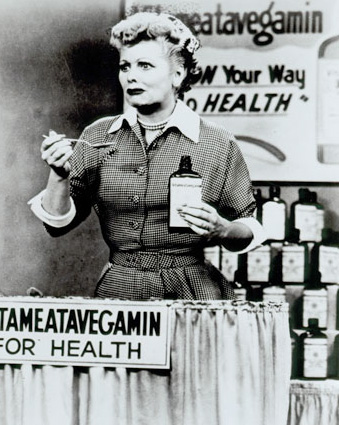
WEBSITE: To
go to my web site, in which I will update food
&
travel information and help link readers to other first-rate travel
& food sites, click on: home page
ARCHIVE: Readers may now access
an
Archive of all past newsletters--each annotated--dating back to July,
2003, by simply clicking on www.johnmariani.com/archive.
SUBSCRIBE AND UN-SUBSCRIBE:
You may subscribe anyone you wish
to this newsletter--free of charge--by
clicking here.
In
This Issue
NEW YORK CORNER: The Modern by John Mariani
NOTES FROM THE WINE CELLAR: Fine Red Burgundy at Affordable Prices by John Mariani
QUICK BYTES
L.A. TODAY
by John Mariani
 Wanna
know what's hurting dining out in Los Angeles these
days? Traffic.
With the amount of time and
fossil fuel it takes you to get from any point in the county to any
other,
a lot of people would rather just eat local or stay home. Thus,
few even think about driving from, say, Santa Monica to downtown, or
from Bel-Air to Marina del Rey, without building an hour of traffic
into the equation. The impetus, then, for restaurateurs to open
new restaurants--or even to open for lunch--is not there out there,
with the exception of the still-proliferating sushi parlors that seem
to
dot every corner of the city at this point.
Wanna
know what's hurting dining out in Los Angeles these
days? Traffic.
With the amount of time and
fossil fuel it takes you to get from any point in the county to any
other,
a lot of people would rather just eat local or stay home. Thus,
few even think about driving from, say, Santa Monica to downtown, or
from Bel-Air to Marina del Rey, without building an hour of traffic
into the equation. The impetus, then, for restaurateurs to open
new restaurants--or even to open for lunch--is not there out there,
with the exception of the still-proliferating sushi parlors that seem
to
dot every corner of the city at this point.Still, a few brave souls have opened new restaurants in L.A., one of which I named as the single Best New Restaurant of 2006 in my round-up for Esquire magazine last month, Wolfgang Puck's remarkable CUT in the Regent Beverly Wilshire Hotel (6525 Sunset Boulevard

Yet by the time I was halfway through my meal at CUT, I knew this was the best new restaurant to open in the U.S. this year. Puck and his gang have not just pushed the envelope on the steakhouse genre—Laurent Tourondel at BLT Steak and Tom Colicchio at Craft in New York have been pioneers—but the Wolfman has made such a stunning job of it all. Every element conspires to make you love the place, from the cordial greeting at the door to the well-informed wine service. (There is also a very sexy Sidebar lounge across the hallway where you can get Kobe-beef sliders with your Martini.)
Curiously, the design of the dining room (right) by Richard Meier (who did The Getty Center), with its sweeping two-tiers, beige-white-black color scheme, ribbon-like ceiling. and expanse of windows, looks somewhat like an executive cafeteria during the day. But at night the place positively glows, with stars twinkling through a dramatic slice of skylight and more light issuing forth from the kitchen. Nothing interferes with sightlines that allow you to see every celeb who’s eating at the sought-after booths. The noise level is civilized, and CUT attracts as many women as male carnivores. Ask for a window table and you’ll get to see everyone get out of their limos and Maseratis in the hotel’s port-cochère.
Puck, with Spago chef Lee Hefter and chef de cuisine Ari Rosenson, have created a menu that includes all the expected USDA Prime cuts—porterhouse, bone-in ribeye, Kansas City sirloin, and New York strip—aged either 21 or 35 days, along with the true Japanese Wagyu beef from Kagoshima Prefecture in Kyushu (it’s dauntingly rich stuff). The don't miss dish? Prime sirloin steak tartare with herb aïoli.
But then there are the starters, like creamy, silky foie gras pavé with date chutney; warm veal tongue with white beans, artichokes, and salsa verde; maple-glazed pork belly with sesame-orange dressing; and a devastatingly good bone marrow flan with mushroom marmalade and parsley salad.
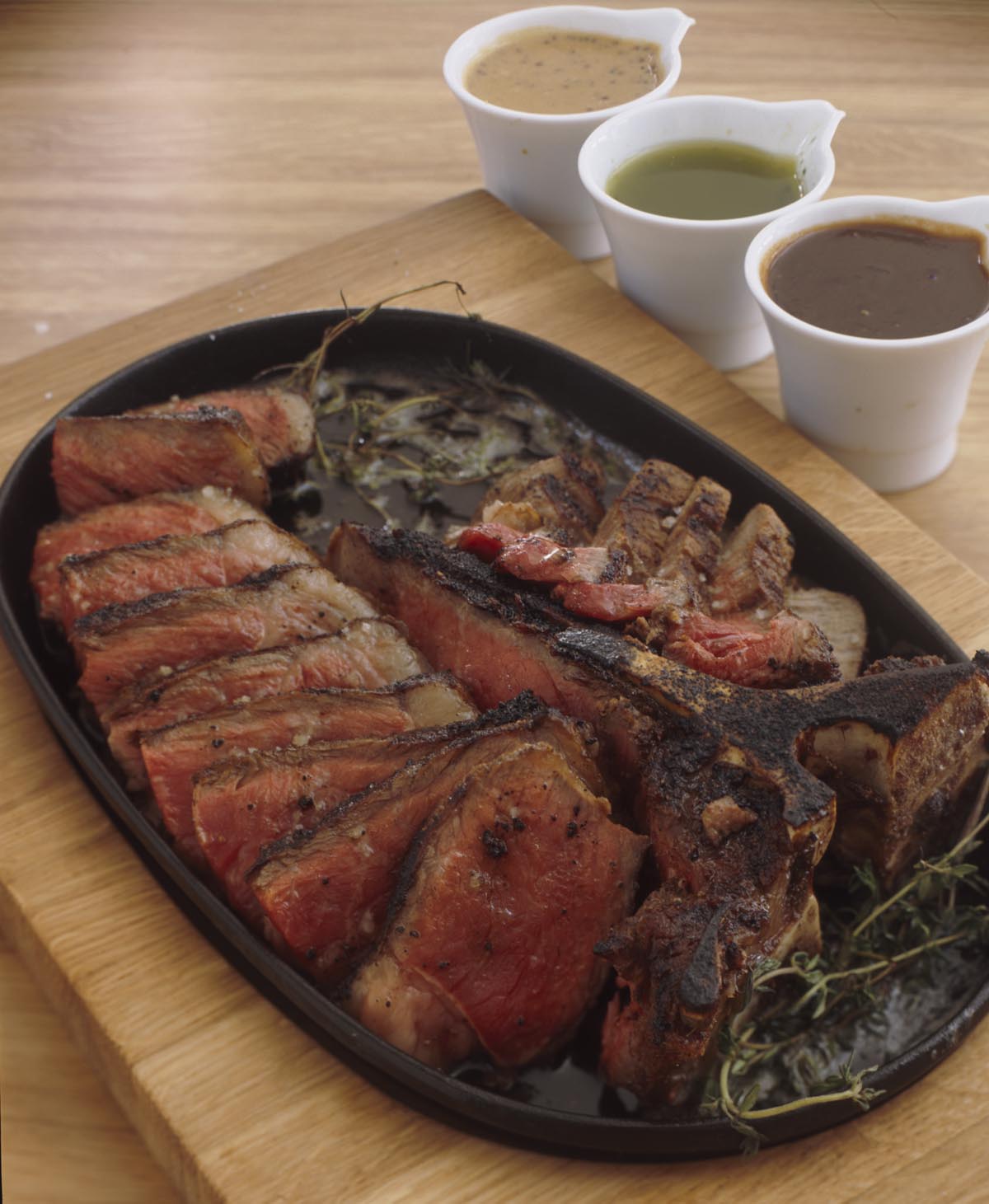 Move
on down the menu for roasted wild
turbot—the finest I’ve ever had this side of the Atlantic—and
pan-roasted
lobster with Thai butter or truffle sabayon.
Side dishes are breathtakingly good, from textbook perfect
tempura onion
rings to potato
tarte Tatin, and Darren McGraw’s desserts are spot-on perfect, like his
“inside-out” profiteroles with chicory-coffee ice cream bar.
Move
on down the menu for roasted wild
turbot—the finest I’ve ever had this side of the Atlantic—and
pan-roasted
lobster with Thai butter or truffle sabayon.
Side dishes are breathtakingly good, from textbook perfect
tempura onion
rings to potato
tarte Tatin, and Darren McGraw’s desserts are spot-on perfect, like his
“inside-out” profiteroles with chicory-coffee ice cream bar.The wine selection, though solid in California cabs and Bordeaux, is not a showy trophy list, nor is it chosen to intimidate; rather its sensible pricing encourages you to try some of the “Native and Displaced Reds” like Turley “Juvenile” Zinfandel.
There is little at CUT you might not find somewhere else, but nowhere does it all come together with such panache, good vibes, and unremittingly good taste. When Puck really puts his mind to it, no one else can create such excitement in a restaurant.
Cut is open for dinner every night. Appetizers run $14-$24, entrees $34-$100.
SIMON
Sofitel Los Angeles
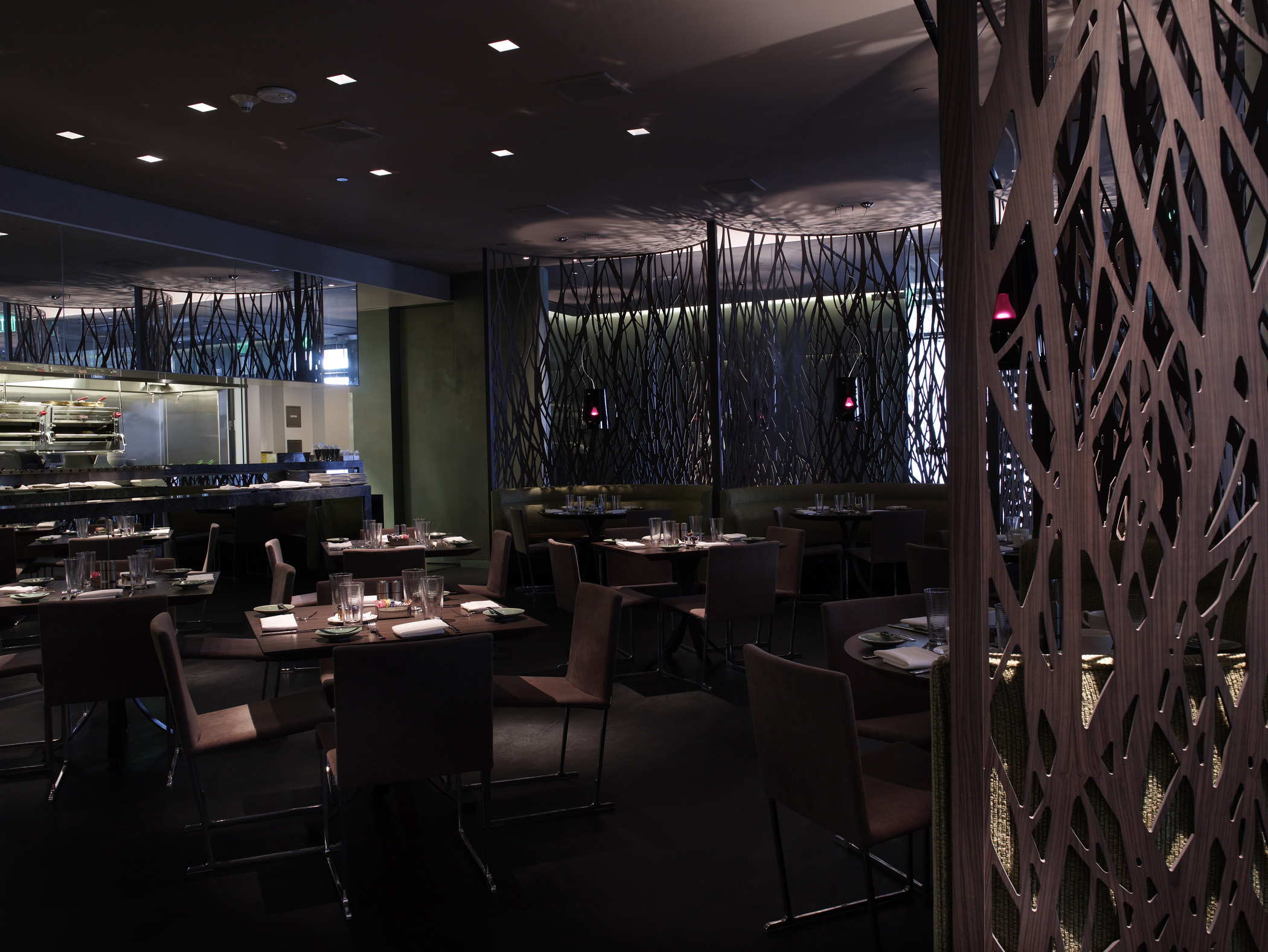
8555 Beverly Boulevard
310-278-5444
www.kerrysimon.com
Having scored a big success at the Hard Rock Café in
Blau helped develop the original restaurants at Bellagio, then at Wynn Las Vegas, and is now out on her own again. Simon has an enviable record of working in NYC kitchens like La Côte Basque, Lutèce,
The food at both Simon restaurants is resolutely American, generously proportioned, and good value throughout, including a superb hamburger. The new place is located next to the Stone Rose Lounge, which has some of the most alluring waitresses in the city. Simon is decked out mostly in tones of gray (it could use more color), with carved wooden screens, hand-loomed rugs, and velvet fabrics. As Irene Virbila, restaurant critics of the L.A. Times, has correctly noted, there's something of a "Norwegian-forest coffee-shop look" about the place during the day, but at night it gets shadowy and seductive. There is also an outdoor patio.
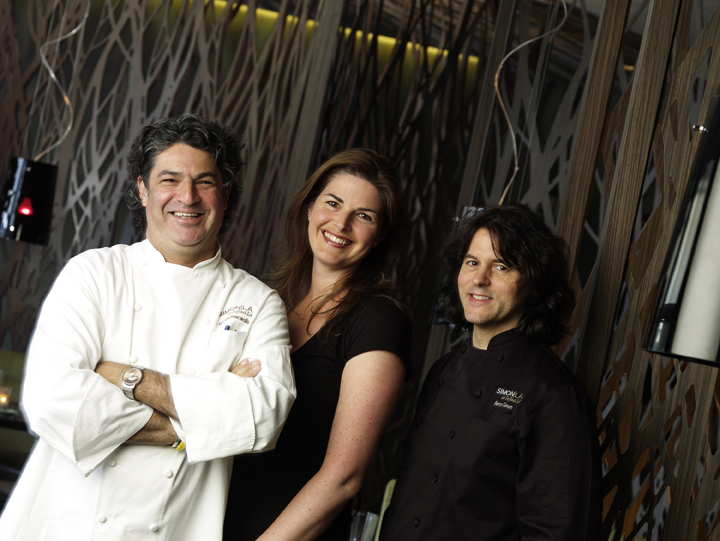 One
of the hit items here is a form of popcorn shrimp, crispy little Gulf
shrimp that are quickly fried and quite addictive, especially when
dipped into a ponzu sauce. Then there's the amusing and very good
"grilled gazpacho," which refers to roasted vegetables turned into a
spicy, chile-hit soup. The wood-oven treatment of a pizza
margherita did not have the incorporation of ingredients down, and it
was a tad too California for my taste.
One
of the hit items here is a form of popcorn shrimp, crispy little Gulf
shrimp that are quickly fried and quite addictive, especially when
dipped into a ponzu sauce. Then there's the amusing and very good
"grilled gazpacho," which refers to roasted vegetables turned into a
spicy, chile-hit soup. The wood-oven treatment of a pizza
margherita did not have the incorporation of ingredients down, and it
was a tad too California for my taste. Surf-and-turf tacos made with strip loin of beef, crispy halibut, guacamole, and fire-roasted salsa packed a lot of pleasure, and the hamburger "fully loaded" lived up to its moniker, a huge, thick, juicy burger (this is no patty) lavished with your choice of cheeses--take 'em all, if you want--and served with spiced Tuscan fried potatoes laced with good (for once) truffle oil--really quite a bargain at $15 for lunch. You can indulge in other Americana like macaroni-and-cheese, creamed spinach, and buttermilk onion rings, and even have "breakfast at lunch"--omelets and a granola parfait.
One would have to be soul-less not to love desserts like pastry chef Jason Etzkin's saffron-caramel braised pear with vanilla saffron ice cream and a honey crisp, or his lemon foam carrot cake with walnut crunch, sweet carrot sauce, and Philadephia cream cheese sherbet: They are all, in a word, swell.
Simon is open daily for breakfast, lunch, and dinner. Dinner appetizers run $10-$38; entrées $18-$48.
SOCIAL HOLLYWOOD
6525 Sunset Boulevard
323-462-5222
www.socialhollywood.com
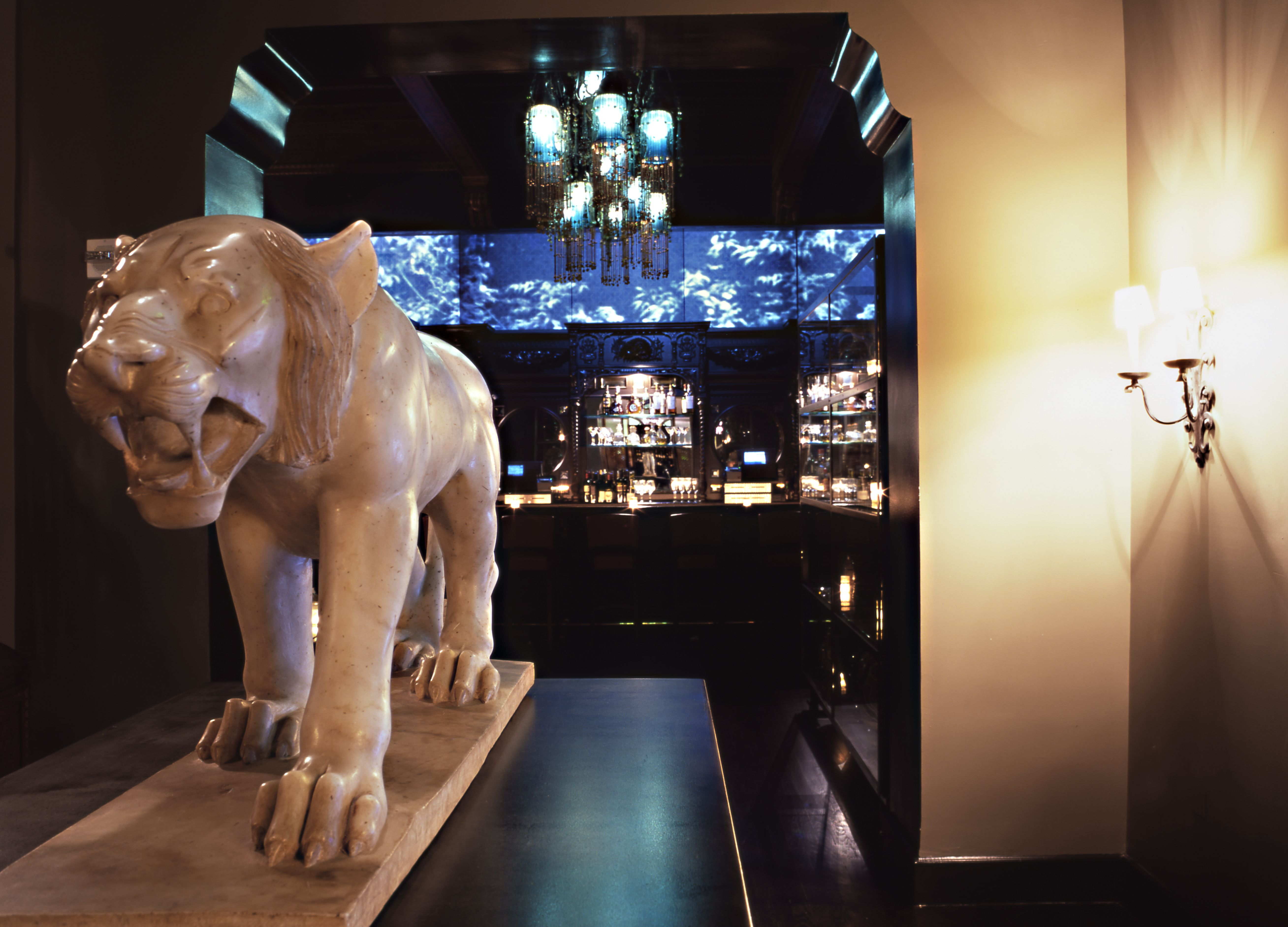 No
one will ever accuse restaurateur Jeffrey Chodorow of dreaming
small. His Miami-based China Grill Management runs 24 restaurants in seven cities, none
of them intimate boites, all of them possessed of a show-biz streak
that is quite manifest in his new Social
Hollywood, an odd name
for an $11 million, 28,000 square-foot nightclub/restaurant that
was formerly the Hollywood
Athletic Club (1923-53), known
for a celebrity
clientele dating back to Chaplin, DeMille, and Valentino.
No
one will ever accuse restaurateur Jeffrey Chodorow of dreaming
small. His Miami-based China Grill Management runs 24 restaurants in seven cities, none
of them intimate boites, all of them possessed of a show-biz streak
that is quite manifest in his new Social
Hollywood, an odd name
for an $11 million, 28,000 square-foot nightclub/restaurant that
was formerly the Hollywood
Athletic Club (1923-53), known
for a celebrity
clientele dating back to Chaplin, DeMille, and Valentino.The place is indeed vast, with a huge, glittering bar (left), upstairs lounges galore, a 4,900-square foot ballroom for special events, and a decibel level of disco music that can blanket conversation. There are also several gaming rooms with billiards and other pastimes.
The 200-seat downstairs dining room, called the Moroccan Room (below), is, however, geared more to a civilized evening of wining and dining. The original vaulted ceilings are here, with much of the original stenciling reclaimed from the 1920s. Still, it's a rather staid room, lacking in decorous excitement.
In the kitchen is Exec Chef Joseph Ojeda, formerly of Asia de Cuba Mondrian, with a consultancy by Miami Chef Michelle Bernstein. Together they have fashioned a menu that is not particularly Moroccan, but instead tilted towards a Mediterranean-tropical style of cooking, with lots of elements from Iberia, Mexico, and Santa Barbara. Thus, you may begin with a lobster bisque en croûte with an "espuma" of sherry, or a chilled foie gras mousse with a fig gel on brioche. Freshly seared foie gras is also available, with braised pineapple and a peanut brittle. A nice meaty crabcake does come with a spicy Moroccan aïoli, avocado, and a refreshing gazpacho consommé shooter. Also, roasted chicken stuffed bastilla-style has a Moroccan spiced reduction, and one of the best dishes here is a tagine of short ribs with celery-truffle gratin, more foie gram, and a tangy-sweet gremolata.
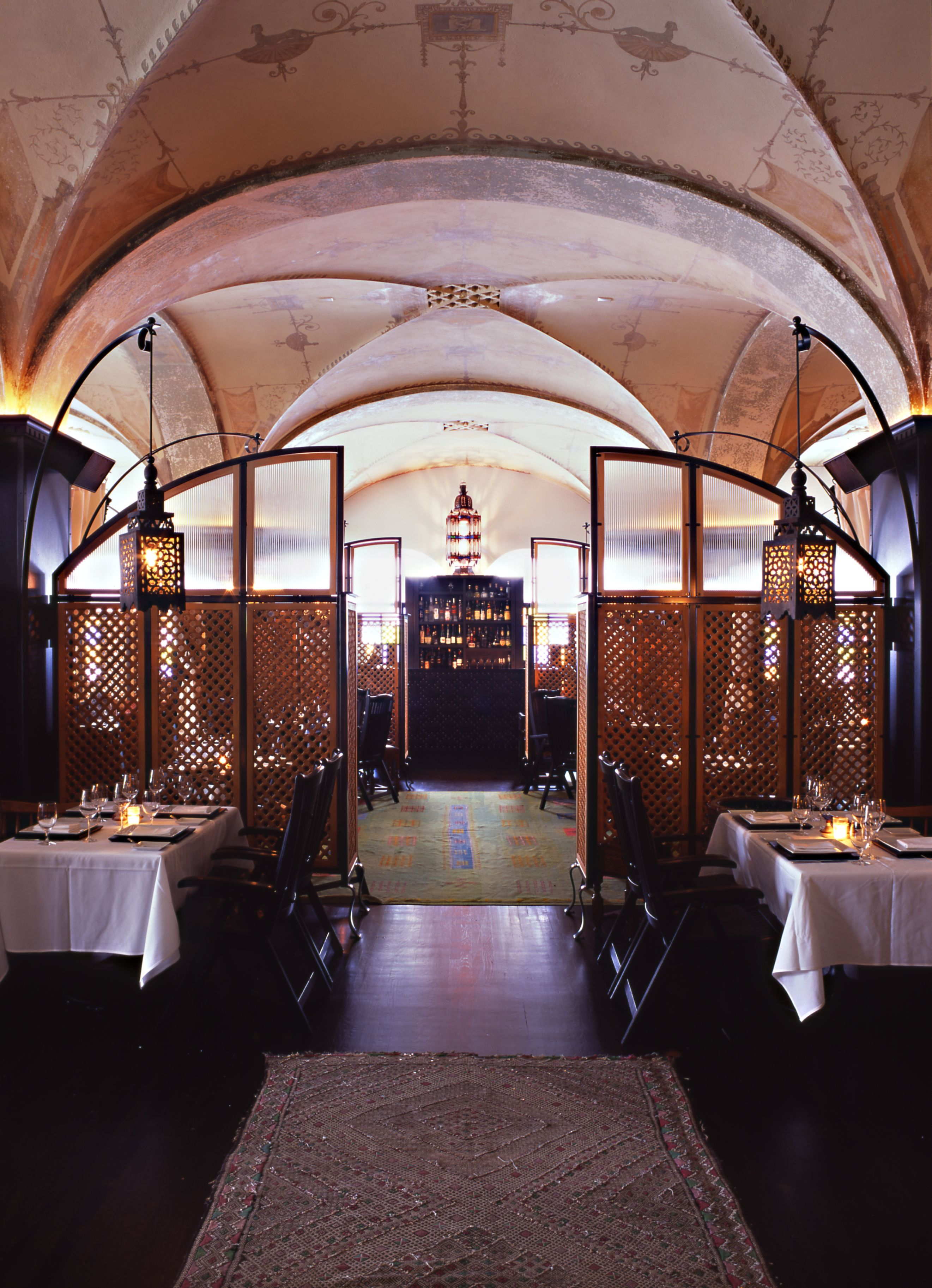
Santa Barbara enters the pitcure by way of its prawns, incorporated into a risotto with a candied seafood nage, while rack of lamb comes glazed with pomegranate over creamy polenta.
For desserts all the stops are pulled out, starting with a "
If the concept and the lounge scene seem to dominate the thinking behind Social Hollywood, those not up for the cacophony, vogue-ing, and Crayola cocktails upstairs can sneak downstairs and have a very good meal indeed.
by John Mariani
9 West 53rd Street
212-333-1220
www.themodernnyc.com
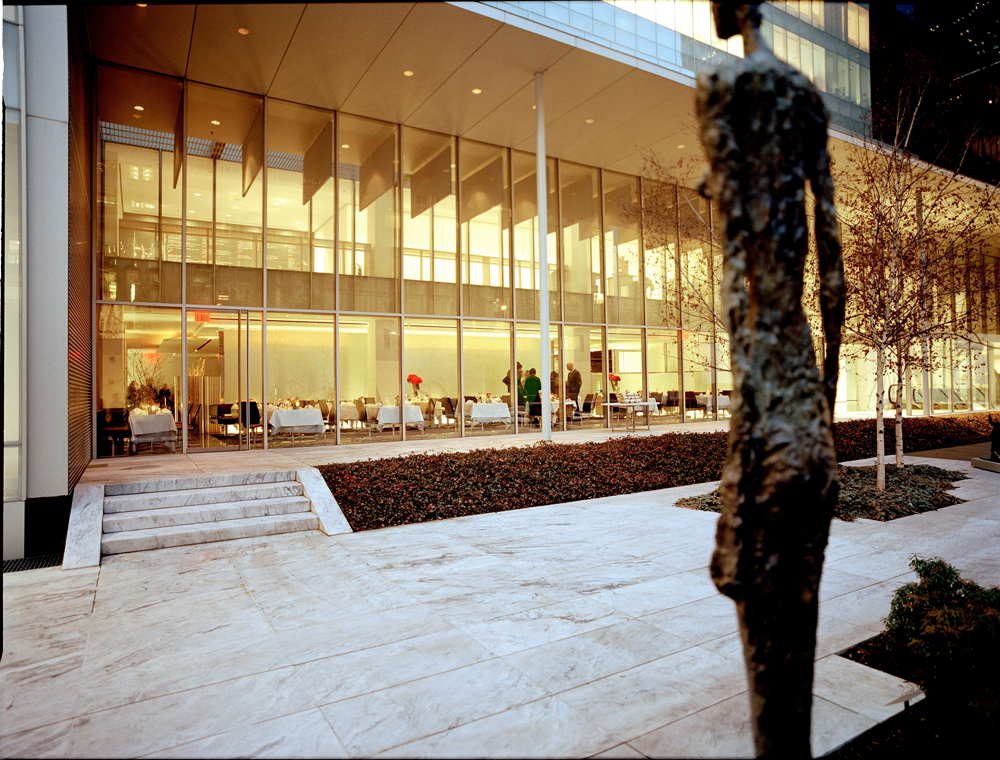 You
may choose to take the following assessment of The Modern with a
large grain of
sea salt, because my son is a cook there, so readily I admit to
both
bias and
paternal pride. Nevertheless the renown of the two-year restaurant and
the
fact that it has, for the second year in a row, garnered a Michelin
star, makes a report on the current menu by Chef
Gabriel Kreuther an update of what I wrote (long before my son worked
there) when I chose The Modern as the Best New Restaurant of 2005 in Esquire.
You
may choose to take the following assessment of The Modern with a
large grain of
sea salt, because my son is a cook there, so readily I admit to
both
bias and
paternal pride. Nevertheless the renown of the two-year restaurant and
the
fact that it has, for the second year in a row, garnered a Michelin
star, makes a report on the current menu by Chef
Gabriel Kreuther an update of what I wrote (long before my son worked
there) when I chose The Modern as the Best New Restaurant of 2005 in Esquire.Certainly the place is as beautiful as ever, appended by designer Peter Bentel to the Museum of Modern Art, with four components: Café 2, which offers mainly Italian charcuterie, pastas, soups, and salads; Terrace 5, devoted mainly to desserts; the Bar Room with a lighter, more casual, but wonderfully tasteful menu; and the main dining room, which is serenely handsome, minimalist, with a floor to ceiling glass wall that overlooks the museum's extraordinary Abby Aldrich Rockefeller Sculpture Garden (above).
Service, under the genteel eye of Managing Director Ana Marie Mormando, has that ease of flow that never shows strain, and Stephane Collings is a sommelier who is happiest when he can find the ideal wine for your meal from a stellar list that gets longer all the time. The three-course prix fixe is $85, with a tasting menu at $125 (with suggested wines, $95 extra), and an autumn tasting menu at $155 (wines, $125). A cheese course runs $18.
At a recent dinner an amuse of cold cubes of apples and butternut squash didn't make too much of an impression, but a sunchoke soup with cured salmon was subtly but fully flavorful. I followed my son's advice to have the pheasant and Burgundy truffle velouté, with millet blinis, and celeriac julienne; the pheasant had the proper gamy hints, with the creaminess of the lightly thickened velouté buoying it all, and the scent of truffles heady in the air. Sautéed Sullivan County fresh foie gras came with dates and a tangy-sweet lemon confit with a crisp chestnut tuile. My wife and I were then treated to two different renderings of Nantucket bay scallops, which are just now coming into their peak of flavor. One was showered with sliced white truffles, a marvelous addition to the delicacy of the sweet little nubbins of seafood. The other was a bit odd, those same scallops accompanied by quince. Mollusks and fruit are rarely paired because they don't have much to do with one another's essences, and this dish did nothing to persuade me otherwise.
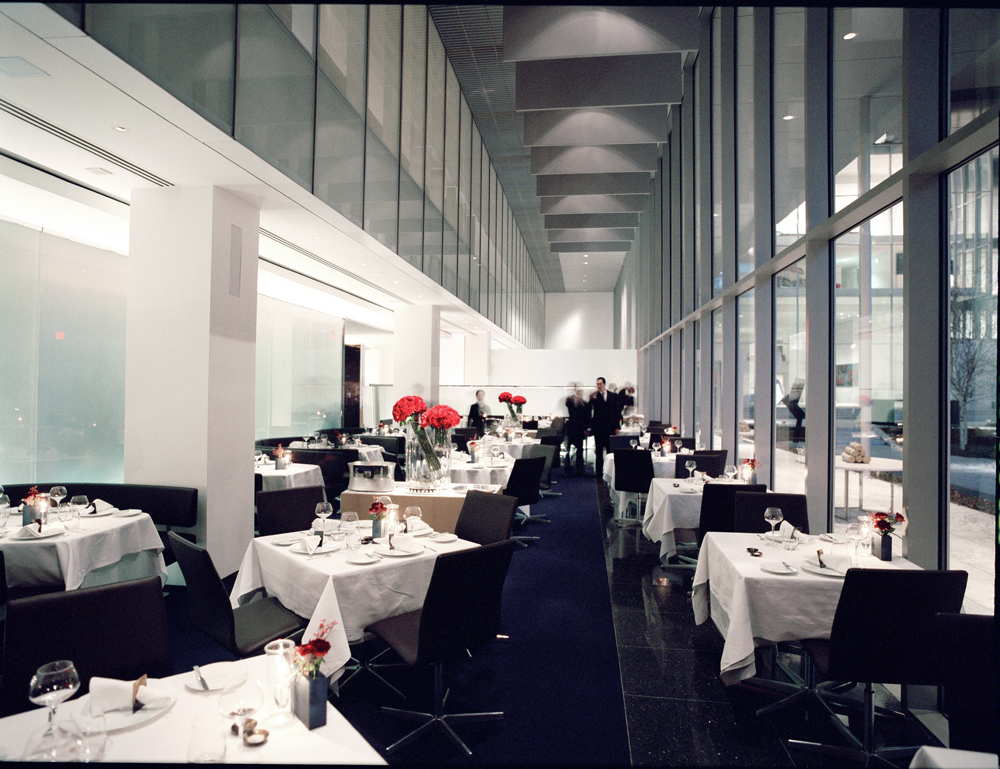
For entrees there was perfectly pink, very juicy, full-flavored squab that was caressed in a crispy pastry, drizzled with a caramelized ginger jus; it reminded me a little of Moroccan or Tunisian brik and the dish bistilla. My wife had a finely grained piece of fat duck breast (not slices) cooked to a rosy turn with black trumpet marmalade and a roulade of pasta called fleischneke wrapped around a forcemeat with sweet raisins, the dish graced with a reduction of Banyuls wine.
The Modern makes some of the best chocolate desserts in town, not least a chocolate tart with a crèmeux, and chocolate sorbet. There was also a lovely lemon cream napoleon, petit-fours, fromage blanc, and--ta-dah!--Concord grape ice cream cones to finish.
It was an enchanting meal in one of those settings you'll only find in New York, on a cool, crisp November evening with no pretense and every kind of comfort applied with that mix of New York hospitality and sophistication that seamlessly balances the familiar and the deferential.
The Modern is open for lunch and dinner Mon.-Sat.
NOTES FROM THE WINE CELLAR
by John Mariani
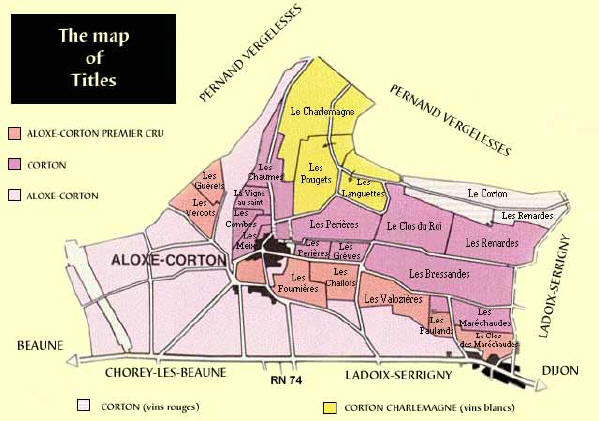 When
friends bemoan the high price of
When
friends bemoan the high price of But the appellations in the Corton region of the Côte de Beaune can get very confusing when 715 acres are in use to produce about 1.5 million bottles a year. Ninety-nine percent is pinot noir red. (Corton Charlemagne is the area’s famous chardonnay-based white wine, which can cost $60 and up.) About 480,000 bottles are made under the highest Grand Cru appellation, with the rest either Aloxe-Corton Premier Cru or simply Aloxe-Corton. But then things get a little dicey: with the Aloxe-Corton appellation, many producers add a specific plot name to the label, with the word “Corton” first: thus, Corton-Maréchaudes is a grand cru selling for $60+, but a label reading “Aloxe-Corton Les Maréchaudes” (also $60+) is a premier cru, because the village name Aloxe-Corton comes first. Still with me?
Then there are the wines labeled simply “Aloxe-Corton,” which is where I find the best-priced wines of the region, rarely above $50 and often around $25. True, they do not possess the richness or complexity of the grand crus, but then they don’t take 10 to 15 years to mature like the grand crus.
Aloxe-Corton (which is pronounced Ah-loss kor-tawn) is pretty much ready to drink by the time it’s shipped to market. These days the vintages you’ll find are 2002 and 2003, both considered among the best of recent years. Aloxe-Corton has a lovely aroma of truffles but rarely possess that identifiable—though for me off-putting--Burgundy smell of feline urine and wet hay. They can be quite buttery, have only a moderate amount of oak, and are ideal with game meats, roast veal, even salmon. Strong cheeses like Reblochon and Epoisses are very well served by the structure and medium body of Aloxe-Corton.
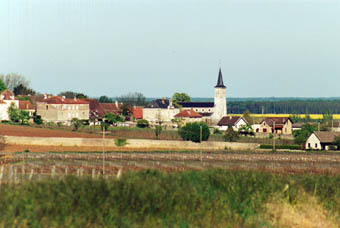
As with all wines in
Having so highly recommended Aloxe-Corton for value, I must say that at least a couple of the examples I tried from 2002 and 2003 at a recent tasting in my home did not rise to the excellence I’d hoped. A 2002 Edmond Cornu & Fils ($30) lacked depth and showed no complexity whatever, with none of the cherry-like aromas and flavors I look for in Aloxe-Corton. Many have praised the 2002 vintage in
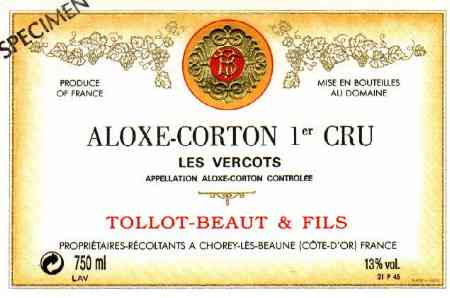 But a 2003 from Domaine Tollot-Beaut
($42) was everything that a fine
But a 2003 from Domaine Tollot-Beaut
($42) was everything that a fine For comparison purposes, I also opened a higher level
Aloxe-Corton is not bargain basement
John Mariani's wine column
appears weekly in the Muse Culture section of Bloomberg.com.
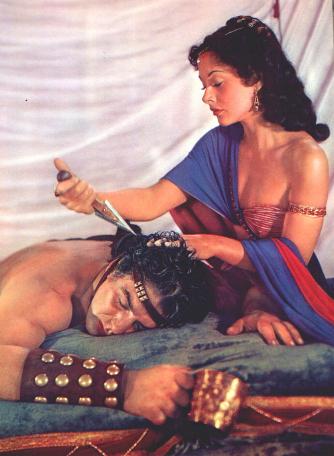
BEST HEADLINE OF THE WEEK

ARTICLES WE NEVER STARTED READING
"Waiter, There’s an Organic Fly in My Soup" by Meredith Ford, in the Atlanta Journal Constitution (Oct. 30. 2006)."
QUICK BYTES
* In NYC, The Kitano celebrates New Year’s Day with
~~~~~~~~~~~~~~~~~~~~~~~~~~~~~~~~~~~~~~~~~~~~~~~~~~~~~~~~~~~~~~~~~~~~~~~~~
MARIANI'S VIRTUAL GOURMET NEWSLETTER is published weekly. Editor/Publisher:
John Mariani. Contributing Writers: Robert Mariani, Naomi
Kooker, Kirsten Skogerson, Edward Brivio, Mort
Hochstein, Suzanne Wright. Contributing
Photographers: Galina Stepanoff-Dargery, Bobby Pirillo. Technical
Advisor: Gerry McLoughlin.
Any of John Mariani's books below
may be ordered from amazon.com by clicking on the cover image.
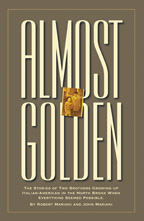 My
newest book, written with my brother Robert Mariani, is a memoir of our
years growing up in the My
newest book, written with my brother Robert Mariani, is a memoir of our
years growing up in the For those of you who don't think of the Robert and I think you'll enjoy this very personal look at our --John Mariani |
 |
 |
 |
 |
 |
 |
copyright John Mariani 2006